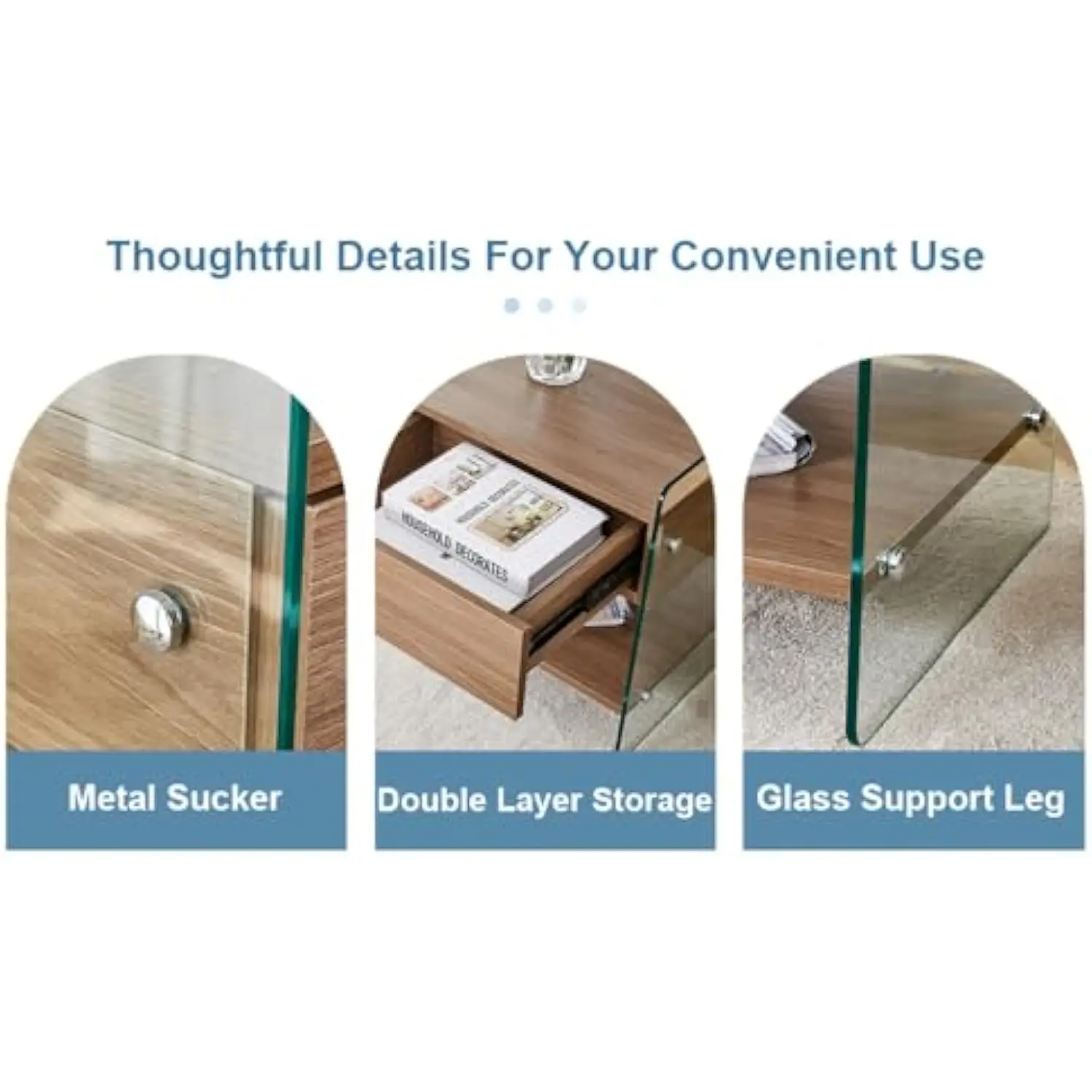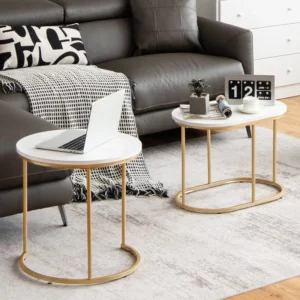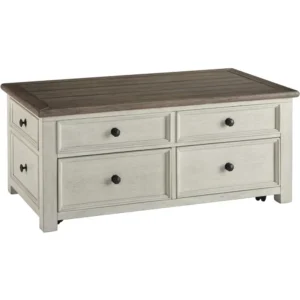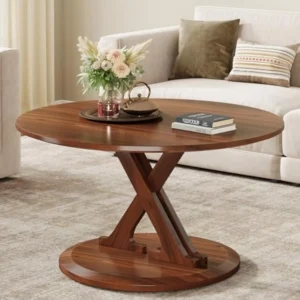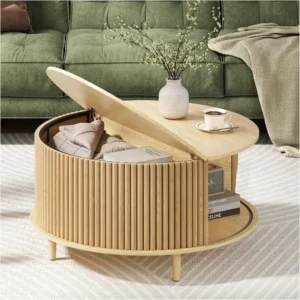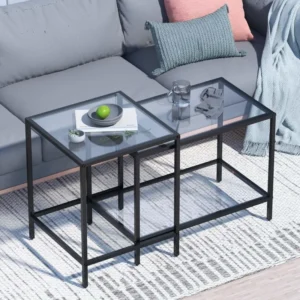Why Compact Coffee Tables Are Essential for Small Living Areas
When space is at a premium, every furniture choice matters. Compact coffee tables—typically measuring under 36 inches (91 cm) in length—serve as the unsung heroes of small living spaces. These scaled-down versions offer the same functionality as their larger counterparts but with a footprint that respects your limited square footage.
Coffee tables play a dual role in any living space. Beyond their obvious functional purpose of providing a surface for drinks, books, and remote controls, they serve as crucial design elements that anchor your seating arrangement and express your personal style.
Compact coffee tables offer several specific advantages for small spaces:
- Optimized floor space that allows for better traffic flow and less crowded rooms
- Visual proportion that creates balance rather than overwhelming a small seating area
- Versatility with many designs offering hidden storage or transformable features
- Easier rearrangement when you need to adapt your space for different activities
The right compact coffee table can make a small room feel intentionally designed rather than cramped. Many black mid-century coffee tables work particularly well in small spaces, as their clean lines and elevated profiles create visual breathing room while providing essential functionality.
Before You Buy: Key Measurements and Space Planning
Successful small space design begins with precise measurements. Before shopping for a compact coffee table, take time to understand the spatial requirements and relationships that will ensure your new piece fits perfectly.
Step 1: Measure Your Available Space
Using a tape measure, determine the maximum footprint your coffee table can occupy while leaving adequate clearance around it. Mark this space on the floor using painter’s tape to visualize the area.
Step 2: Consider Height Relationships
The ideal coffee table height sits 1-2 inches (2.5-5 cm) lower than your sofa seat height. This relationship ensures comfortable access while maintaining visual harmony. Measure from the floor to the top of your sofa cushions to find this dimension.
Step 3: Apply the Two-Thirds Rule
A well-proportioned coffee table should be approximately two-thirds the length of your sofa. For a 60-inch sofa, look for a coffee table around 40 inches long. In compact spaces, you might need to scale this down further.
Step 4: Ensure Adequate Clearance
Allow at least 18 inches (45 cm) of pathway space around your coffee table for comfortable movement. This clearance is non-negotiable, even in the smallest spaces.
For truly small spaces, look for tables between 24-36 inches (61-91 cm) in length. Many perfect compact coffee tables for small spaces fall within this range, offering the ideal balance between functionality and space efficiency.
Our collection of small coffee tables includes carefully measured pieces designed specifically for compact living environments.
Assessing Your Lifestyle Needs: Finding the Right Functionality
Before selecting a compact coffee table, consider how you’ll actually use it in daily life. The right functionality can transform a simple surface into an essential part of your living space ecosystem.
Ask yourself these key questions:
- How do you typically use your living space? Do you need a surface primarily for casual drinks, or do you regularly dine, work, or play games on your coffee table?
- What items do you need to store? Remote controls, magazines, throws, and board games all require different storage solutions.
- How often do you rearrange your space? If you frequently reconfigure your room for different activities, a lightweight, mobile design might be essential.
- Do you have children or pets? Safety considerations like rounded corners and sturdy construction become paramount with little ones around.
- How many people typically use the space? A table that works for one or two people might feel cramped when guests visit.
Your answers will guide specific feature priorities. For example, a remote worker in a studio apartment might prioritize a lift-top table that transforms into a laptop desk, while a family in a small home might need sturdy construction with rounded corners and some hidden storage for toys.
Understanding how to maximize your coffee table usage helps ensure you select a piece that truly enhances your living experience rather than just filling space.
Space-Saving Coffee Tables with Storage: Hidden Organization
In small spaces, every piece of furniture should work double-duty. Storage coffee tables represent the perfect marriage of form and function, offering both a surface for daily activities and valuable space to conceal or display your belongings.
Drawer Storage
Tables with integrated drawers provide concealed storage without altering the table’s silhouette. Look for:
– Full-extension drawer slides for complete access
– Divided compartments for organization
– Soft-close mechanisms to prevent slamming
Open Shelf Storage
Open shelving beneath the tabletop offers a combination of display and storage opportunities:
– Perfect for frequently used items and decorative pieces
– Creates visual lightness compared to solid bases
– Allows for flexible organization with baskets or dividers
Lift-Top Storage
Perhaps the most versatile option, lift-top tables feature a raising mechanism that reveals storage beneath:
– Provides the largest storage capacity
– Creates an impromptu work surface at a comfortable height
– Conceals items completely from view
Hidden Compartments
Some innovative designs include sliding panels, rotating sections, or other clever mechanisms to reveal unexpected storage spaces.
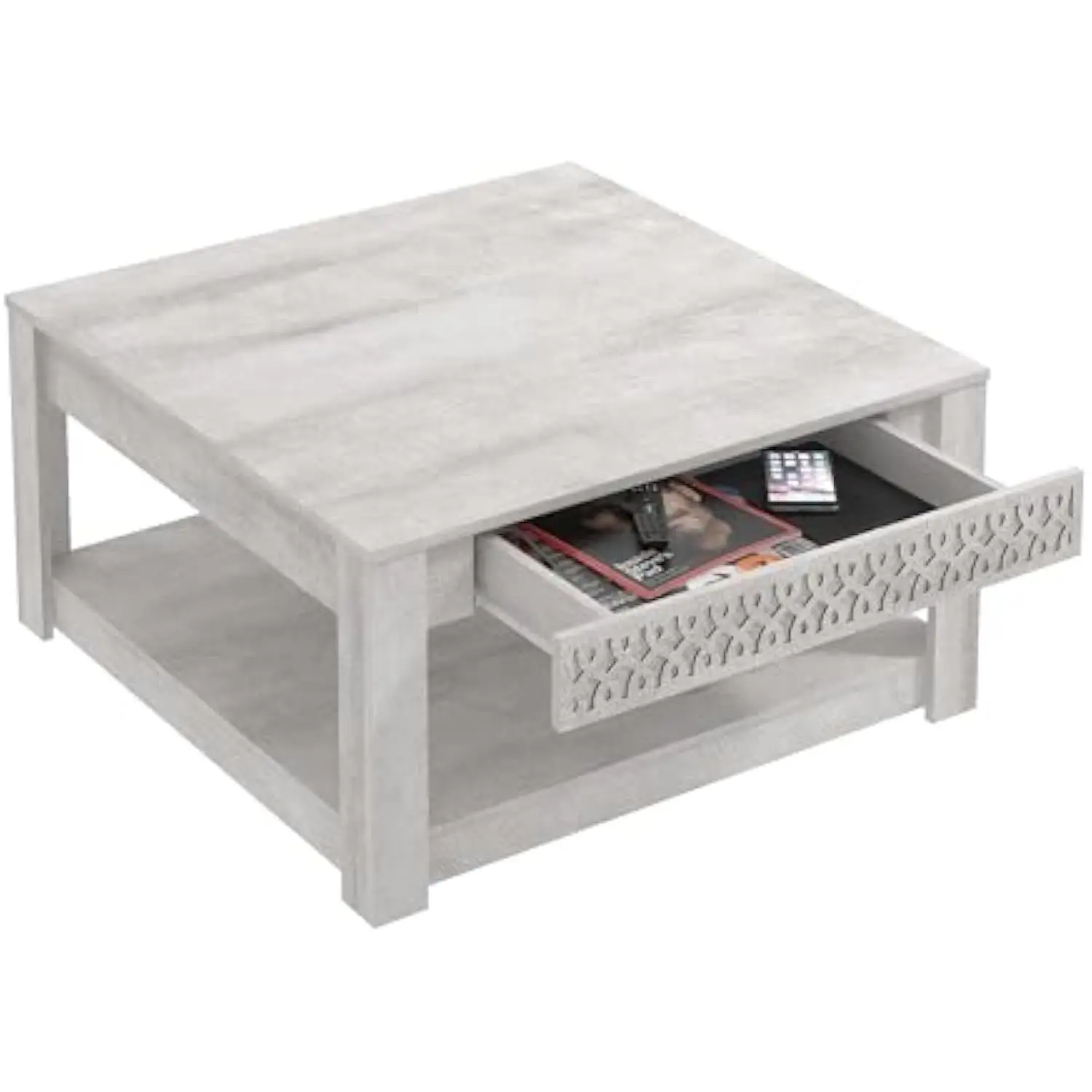
Pros:
– Eliminates the need for additional storage furniture
– Keeps frequently used items within easy reach
– Reduces visual clutter in small spaces
Cons:
– Often heavier and more difficult to move
– Generally more expensive than simple tables
– May have slightly reduced surface area to accommodate storage features
For versatile storage options, browse our selection of lift-top coffee tables designed specifically for space-constrained environments.
Transformable and Multi-Purpose Designs for Maximum Utility
When square footage is limited, furniture that can adapt to different needs becomes invaluable. Transformable coffee tables represent the pinnacle of space-efficient design, offering multiple functions within a compact footprint.
Lift-Top Tables
These clever designs feature tops that raise to create a comfortable work or dining surface:
– Height typically adjusts from standard 16-18 inches to 24-26 inches
– Weight capacity usually ranges from 15-50 pounds depending on the mechanism quality
– Provides ergonomic positioning for laptop work or casual dining
Pros: Creates a proper height surface for working or eating without additional furniture
Cons: Mechanisms may wear over time with frequent use
Nesting Tables
Sets of two or three tables of graduating sizes that store compactly together:
– Can be separated to provide multiple surfaces when entertaining
– Often feature contrasting or complementary materials
– Typically very lightweight for easy movement
Pros: Extremely adaptable for different scenarios and guest counts
Cons: Individual tables may be quite small with limited surface area
Convertible Height Tables
These tables adjust from coffee table height to dining table height:
– Transformation mechanisms include hydraulic lifts, manual cranks, or locking telescopic legs
– Surface area often expands as well as rises
– Can completely eliminate the need for a separate dining table
Pros: Maximizes functionality in minimal space
Cons: May be heavier and more complex mechanically
C-Tables and Side Tables
When extremely tight on space, a cluster of small side tables or C-shaped tables (that slide under sofas) can substitute for a traditional coffee table:
– Can be easily rearranged and separated
– Minimal footprint when not in use
– Often more affordable than larger pieces
For versatile options that maximize space efficiency, explore our collection of nesting coffee tables that provide flexible surfaces when needed.
Finding the Right Shape: Impact on Space and Movement
The shape of your coffee table significantly influences both traffic flow and visual impact in small spaces. Each geometric form offers distinct advantages and challenges when space is at a premium.
Round and Oval Tables
Round coffee tables create smooth pathways around them with no sharp corners to navigate—ideal for tight spaces where every inch counts.
- Traffic Flow Benefits: People naturally flow around curved edges without awkward movements
- Safety Advantage: No sharp corners make these ideal for households with children
- Visual Effect: Softens spaces dominated by rectangular furniture and architecture
- Best Placement: Central seating arrangements where movement occurs on all sides
- Optimal Diameter: 30-36 inches (76-91 cm) for compact spaces
Square Tables
Square tables offer geometric simplicity and maximize usable surface area within their footprint.
- Best Applications: Perfect with sectionals or when four people need equal access
- Space Efficiency: Makes the most of square rooms where other shapes might waste space
- Visual Impact: Creates pleasing symmetry and balance
- Ideal Dimensions: 24-30 inches (61-76 cm) for small spaces
Rectangular Tables
The classic coffee table shape can still work in small spaces when properly scaled.
- Suitable Scenarios: Narrow rooms or when paired with a standard sofa
- Proportion Recommendation: Aim for length-to-width ratio of approximately 2:1
- Footprint Minimization: Look for slender designs with thin profiles and lighter visual weight
- Recommended Size: 36 inches × 18 inches (91 cm × 46 cm) maximum for compact spaces
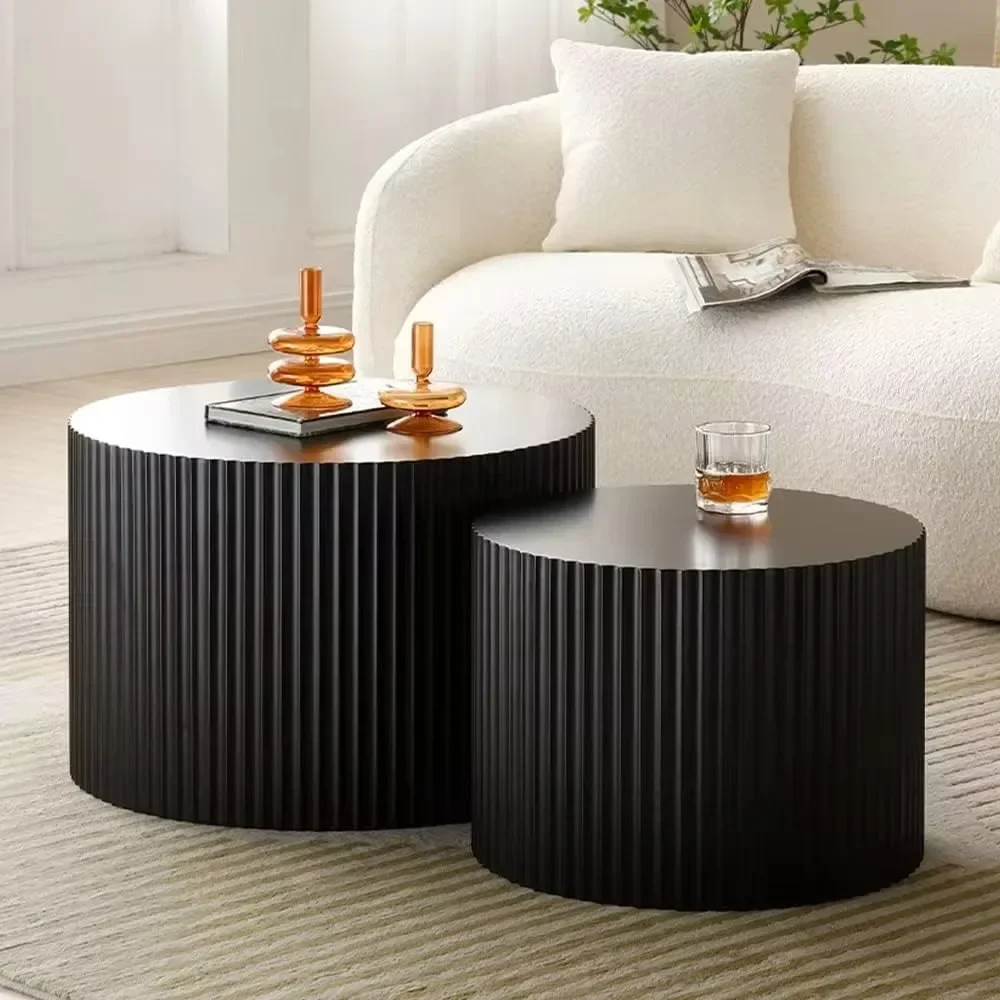
Unique Shapes
Triangular, kidney-shaped, or organic-form tables can solve specific space problems while adding visual interest.
- Statement Value: Creates a focal point in minimal space
- Problem-Solving Capability: Unusual shapes can fit spaces where standard geometries won’t work
- Space Consciousness: Choose shapes that echo your room’s architecture or work around existing obstacles
Understanding how to choose the perfect coffee table shape for your specific room configuration can make a significant difference in both functionality and visual spaciousness.
Material Selection for Small Space Coffee Tables
The materials you choose for your compact coffee table can dramatically affect how spacious your room feels. Beyond aesthetics, each material brings distinct practical considerations for small-space living.
Glass and Acrylic
Pros:
– Creates visual openness that makes rooms feel larger
– Reflects light to brighten small spaces
– Extremely easy to clean
– Resistant to water damage and stains
Cons:
– Shows fingerprints and dust easily
– Can be a safety concern in households with children
– May feel cold or uninviting without textile accents
– Typically heavier than it appears (glass)
Glass tops work best when paired with slender bases that maintain the airy quality. Glass coffee tables are particularly effective at creating visual space in tight quarters.
Wood Options
Light Woods (Maple, Ash, Birch):
– Brighten spaces and feel visually lighter
– Add warmth without visual heaviness
– Typically 20-30% lighter in physical weight than dense hardwoods
– Show wear more visibly than darker woods
Dark Woods (Walnut, Mahogany):
– Create sophisticated focal points
– Hide marks and scratches better
– May visually reduce perceived space
– Provide striking contrast in neutral rooms
Engineered Wood and Veneers:
– More affordable than solid wood
– Lighter weight for easier movement
– Less prone to warping in varying humidity
– Environmental sustainability advantages
Metal Designs
Pros:
– Open frame designs preserve visual space
– Extraordinary strength-to-weight ratio
– Extremely durable and stable
– Contemporary aesthetic with industrial appeal
Cons:
– Can feel cold without softening elements
– May scratch flooring if not properly protected
– Often noisy if items are placed directly on surface
Metal works particularly well in combination with other materials—glass tops with metal frames or wood tops with metal legs provide balanced weight and visual interest.
Stone and Concrete
Best Applications:
– Small accent pieces rather than full-sized tables
– Inset sections combined with lighter materials
– Thin slabs rather than thick blocks
Considerations:
– Extraordinarily heavy (often 3-4 times the weight of wood)
– Permanently fixed placement due to weight
– Excellent heat resistance and durability
– Cool, sophisticated aesthetic
Upholstered Options (Ottomans)
Pros:
– Dual functionality as both seating and table
– Soft edges ideal for households with children
– Can add texture and color to a room
– Often include hidden storage
Cons:
– Less stable surface for drinks and fragile items
– Require trays for practical table functionality
– More vulnerable to stains and damage
– Shorter lifespan than hard-surface options
Matching Your Coffee Table to Your Décor Style
A well-chosen coffee table should feel like an integral part of your décor scheme rather than an afterthought. Here’s how to select a compact table that complements various interior styles while respecting space limitations.
Modern & Minimalist Approaches
Modern minimalist spaces thrive on clean lines and breathing room—qualities that naturally complement small space design.
Key Characteristics:
– Sleek profiles with minimal ornamentation
– Emphasis on horizontal planes and low profiles
– Often monochromatic with occasional bold color accents
– Materials: glass, engineered wood with matte finishes, powder-coated metals
Recommendations:
– Choose tables with hidden storage to maintain clutter-free surfaces
– Look for floating designs with visible space beneath
– Prioritize simple geometric forms (perfect circles, precise rectangles)
– Limit visible hardware and embellishments
Scandinavian Style Solutions
Scandinavian design harmonizes beautifully with compact living, emphasizing functionality, light colors, and natural materials.
Key Elements:
– Light wood tones (particularly oak, ash, and birch)
– Rounded edges and organic forms
– Pale color palettes with textural interest
– Emphasis on craftsmanship and thoughtful details
Recommendations:
– Select tables with tapered legs that create airiness
– Incorporate natural wood grain as a visual element
– Look for multifunctional designs with smart storage
– Choose pieces with a hand-crafted quality
Industrial Style Considerations
Industrial style can work in small spaces when properly scaled down and lightened up.
Key Features:
– Mixed material construction (metal with wood, glass, or concrete)
– Visible hardware and mechanical elements
– Utilitarian shapes with emphasis on function
– Weathered or distressed finishes
Recommendations:
– Choose open-frame metal designs that maintain visual space
– Opt for lighter finishes rather than heavy dark metals
– Look for industrial elements on a smaller scale
– Select pieces with wheels for flexible placement
Mid-century Modern Options
Mid-century modern design principles align perfectly with space-efficient furniture needs.
Defining Elements:
– Tapered legs that create open space beneath
– Organic curves mixed with geometric forms
– Warm wood tones (particularly walnut and teak)
– Functional simplicity with elegant details
Recommendations:
– Look for authentic proportions that honor original designs
– Select pieces with raised profiles on slender legs
– Consider classic shapes scaled down for contemporary spaces
– Embrace warm wood tones that add character without heaviness
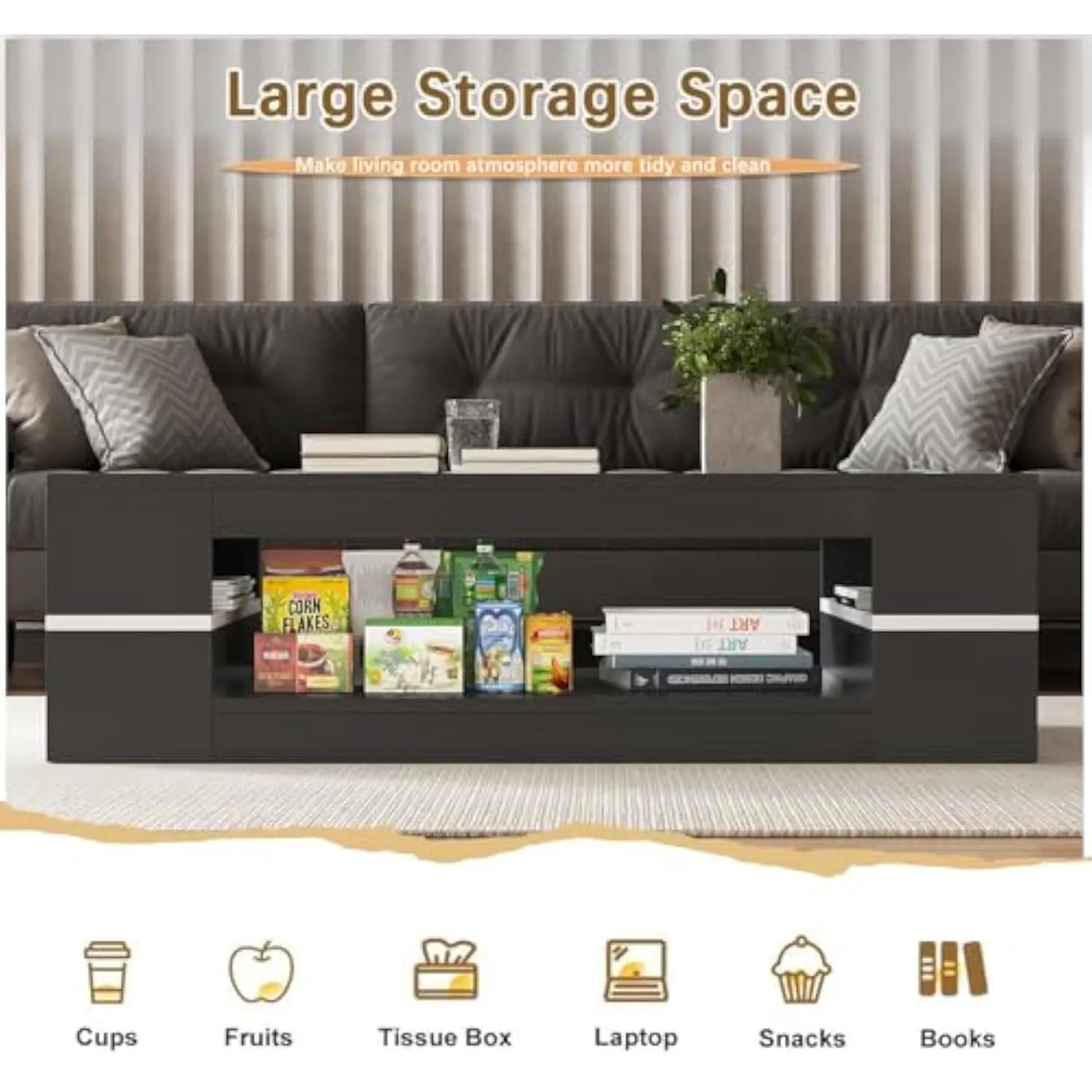
Farmhouse and Rustic Adaptations
Farmhouse style can be adapted for small spaces by focusing on lighter finishes and scaled-down rustic elements.
Key Characteristics:
– Distressed or whitewashed wood
– Simple, sturdy construction
– Textural interest and natural materials
– Vintage or repurposed qualities
Recommendations:
– Choose lighter finishes over dark, heavy woods
– Look for slimmer profiles of classic farmhouse designs
– Incorporate subtle rustic details rather than oversized elements
– Select pieces with visible storage options like simple shelving
For more style guidance specific to certain aesthetics, explore our collection of black mid-century modern coffee table styles that complement various décor approaches.
Practical Features to Prioritize for Small Space Living
Beyond aesthetics and dimensions, certain functional features significantly impact a coffee table’s suitability for small space living. Here’s what to prioritize when evaluating compact coffee table options.
Stability & Structure
- Wider base-to-top ratio increases stability despite smaller footprints
- Adjustable feet help compensate for uneven floors
- Corner bracing and proper joinery improve durability in smaller frames
- Anti-tip features become especially important for designs with storage drawers
Weight Capacity Considerations
- Standard coffee tables should support 100-150 pounds minimum
- Lift-top mechanisms typically support 15-40 pounds when extended
- Glass tops generally have lower weight capacities than solid surfaces
- Consider capacity needs based on intended use (laptop work, dining, etc.)
Assembly & Delivery
- Compact packaging that can navigate tight doorways and narrow staircases
- Tool-free assembly options save space and hassle
- Modular designs that can be assembled in place
- Clear, detailed instructions with adequate hardware
Maintenance Requirements
- Removable glass for easy cleaning
- Stain-resistant finishes for wood surfaces
- Dust-resistant designs with minimal crevices
- Appropriate materials for households with children and pets
Safety Features
- Rounded or beveled edges that prevent injuries
- Non-toxic finishes free from VOCs and formaldehyde
- Pinch-free mechanisms on transforming tables
- Adequate weight to prevent tipping but not so heavy as to cause injury when moved
Understanding the important features of quality coffee tables helps ensure your purchase stands up to daily use while accommodating the special requirements of compact living environments.
Budget Planning: What to Expect at Different Price Points
Setting realistic budget expectations helps you make informed decisions when shopping for a compact coffee table. Here’s what you can typically expect at various price points.
Entry-level Options ($50-150)
At this price range, you’ll generally find:
– Engineered wood (particleboard or MDF) with laminate finishes
– Simple designs with limited or no storage features
– Basic assembly requirements with standard hardware
– Fewer size options and standardized dimensions
– Limited warranty coverage (typically 1 year or less)
While these budget-friendly options can be functional, they may have shorter lifespans and less distinctive styling. Look for pieces that prioritize sturdy construction over decorative details for the best value.
Mid-range Selections ($150-300)
This middle bracket typically offers:
– Higher quality engineered wood with better veneers or solid wood components
– Some genuine solid wood options in smaller sizes
– More varied design choices with better hardware
– Basic storage features like simple drawers or shelves
– Better weight capacity and stability
– Extended warranties (1-3 years)
This range represents the sweet spot for many small-space dwellers, offering reasonable quality and attractive design without premium pricing.
Higher-end Investments ($300+)
Premium compact coffee tables generally provide:
– Solid wood construction or premium materials throughout
– Designer styling with distinctive details
– Advanced features (precision mechanisms, specialized storage)
– Superior craftsmanship and joinery techniques
– Exceptional stability and durability
– Extended or lifetime warranties
When investing at this level, you’re paying for longevity, unique design, and superior materials that will maintain their quality for many years.
For budget-friendly but stylish options, explore our small apartment coffee table ideas that balance cost with quality and functionality.
Expert Placement Tips for Small Space Coffee Tables
Strategic placement of your compact coffee table can maximize both functionality and perceived space in tight quarters.
1. Establish the Perfect Distance
Position your coffee table approximately 18 inches (45 cm) from your seating. This distance allows comfortable leg extension while keeping drinks and items within easy reach. In extremely tight spaces, you can reduce this to 14-16 inches (35-40 cm), but avoid going closer as it restricts movement.
2. Create Visual Balance
Your coffee table should be proportional to surrounding furniture. As a general rule, aim for a height that’s 1-2 inches (2.5-5 cm) lower than your sofa seat and a length that’s between half and two-thirds of your sofa’s length. This creates pleasing visual harmony even in limited space.
3. Define Conversation Areas
Use your coffee table to anchor and define your seating arrangement. Even in small spaces, a well-placed coffee table creates a sense of intentional design rather than haphazard furniture placement.
4. Plan Traffic Patterns
Ensure at least 24 inches (61 cm) of passage space on main traffic sides of your coffee table. If space is extremely limited, consider a table that can be easily moved or a C-shaped side table that tucks under your sofa when not in use.
5. Style Without Clutter
For small coffee tables, follow the rule of three: limit decorative items to three objects of varying heights and visual weights. Consider these styling approaches:
– A single focal point (like a distinctive plant or sculpture)
– Stacked books with a small decorative object on top
– A low profile tray that organizes remote controls and small items
– Nested objects that can be spread out when more table space is needed
Mid-Century Modern Lift Top Coffee Tables, Mid-Century Modern Square Coffee Tables
$454.73 Select options This product has multiple variants. The options may be chosen on the product pageMid-Century Modern Nesting Coffee Tables, Mid-Century Modern Nesting Table Sets
$361.45 Select options This product has multiple variants. The options may be chosen on the product pageMid-Century Modern Lift Top Coffee Tables
$1,101.12 Select options This product has multiple variants. The options may be chosen on the product pageMid-Century Modern Round Coffee Tables, Mid-Century Modern Small Coffee Tables
$452.73 Select options This product has multiple variants. The options may be chosen on the product pageMid-Century Modern Round Coffee Tables, Mid-Century Modern Small Coffee Tables
Price range: $459.95 through $488.75 Select options This product has multiple variants. The options may be chosen on the product pageMid-Century Modern Black Coffee Tables, Mid-Century Modern Glass Top Coffee Tables, Mid-Century Modern Nesting Coffee Tables, Mid-Century Modern Nesting Table Sets, Mid-Century Modern Square Coffee Tables
$197.51 Select options This product has multiple variants. The options may be chosen on the product page
For more ideas on maximizing your coffee table’s visual impact in small spaces, explore our guide to styling mid-century coffee tables in limited spaces.
Best Compact Coffee Tables for Specific Needs
Different living situations demand specific solutions. Here are targeted recommendations for common small-space challenges.
For Extremely Limited Spaces (Under 24 inches/61 cm)
When every inch counts, consider these ultra-compact options:
– Round tables with 20-24 inch diameters
– C-shaped tables that slide partially under sofas
– Wall-mounted folding designs that can be collapsed when not needed
– Nesting table sets with the smallest table used as primary surface
For Small Apartments with Storage Needs
Maximize functionality with these storage-focused solutions:
– Lift-tops with deep compartments for blankets and larger items
– Tables with integrated charging stations for electronics
– Designs with both open shelving (for display) and closed storage (for clutter)
– Multi-level tables with staggered surfaces for different functions
For Flexible Social Spaces
When entertaining is a priority even in small spaces:
– Expandable designs that extend for guests
– Nesting tables that separate to provide drink surfaces for multiple seating positions
– Height-adjustable tables that transform from coffee table to dining surface
– Lightweight tables on casters for easy reconfiguration
Explore our selection of best compact mid-century coffee tables for recommendations tailored to different specific needs.
Coffee Table Alternatives for the Smallest Spaces
When traditional coffee tables simply won’t fit, creative alternatives can provide similar functionality without consuming precious floor space.
When to Consider Alternatives
- Studios under 400 square feet (37 square meters)
- Living areas that must accommodate multiple functions
- Rooms with challenging architectural features like columns or angled walls
- Spaces where accessibility requires wider clearance for mobility aids
Creative Solutions
- Stacking Floor Cushions or Poufs: These soft surfaces double as extra seating and can be pushed aside when not needed
- Wall-Mounted Drop-Leaf Surfaces: These fold down only when needed and take up zero floor space when collapsed
- Repurposed Items: Vintage trunks, suitcases, or wooden crates offer character while providing surface area and storage
- Side Table Clusters: A collection of small drink tables scattered throughout the seating area provides surface space without a central obstacle
Comparison to Traditional Coffee Tables
| Alternative | Pros | Cons |
|---|---|---|
| Floor Poufs | Soft, kid-friendly, double as seating | Unstable surface, requires tray for drinks |
| Drop-Leaf Wall Tables | Zero floor space, highly adaptable | Limited storage, requires wall mounting |
| Repurposed Items | Unique character, often includes storage | Inconsistent heights, may lack stability |
| Side Table Cluster | Flexible placement, easily moved | Less visual cohesion, smaller individual surfaces |
Frequently Asked Questions About Compact Coffee Tables
What is considered “too small” for a coffee table?
A coffee table becomes too small when it can’t comfortably serve its primary functions. As a general rule, anything less than 16 inches (40 cm) wide will struggle to hold a book and drink simultaneously. Length-wise, a table less than half your sofa length will appear disproportionately tiny.
Can a coffee table be taller than my sofa?
While traditional design rules suggest coffee tables should be 1-2 inches lower than sofa seat height, contemporary design does occasionally feature taller tables. If choosing this unconventional approach, limit the height difference to no more than 2 inches above seat height to maintain functionality and comfort.
Are nesting tables practical for daily use?
Nesting tables are exceptionally practical for small spaces with fluctuating needs. For daily use, the largest table serves as your primary coffee table, while the nested smaller tables remain tucked away. When entertaining, the additional surfaces can be distributed around your seating area for guests.
How can I make my small coffee table more functional?
Enhance functionality by adding a tray to corral small items, implementing vertical storage solutions nearby, choosing a table with built-in features like storage or adjustability, and keeping the surface clutter-free by establishing a “clear daily” policy for items that don’t permanently live there.
What’s the best shape for a very narrow living room?
For narrow rooms, rectangular tables with a slender profile work best when placed parallel to the sofa. Look for tables no wider than 18-20 inches (45-50 cm) with a length proportional to your sofa. Oval tables can also work well as they eliminate sharp corners in tight pathways.
Shopping Guidance: Where to Find Quality Compact Coffee Tables
When shopping for a compact coffee table, knowing what to look for in product descriptions and specifications can help you make an informed decision without seeing the piece in person.
Key Specifications to Verify
- Precise Dimensions: Beyond length and width, check height, shelf clearances, and drawer interior measurements
- Material Details: Look for specific wood types and quality indicators like “solid wood” versus “wood veneer”
- Weight Capacity: Confirm both the total table capacity and specific capacities for features like lift-tops
- Assembly Requirements: Note tool requirements, estimated assembly time, and the number of parts
- Warranty Coverage: Check duration and what’s specifically covered (structural elements, mechanisms, finishes)
Quality Indicators in Descriptions
- Joinery methods mentioned (mortise and tenon, dovetail, etc.)
- Wood kiln-drying processes noted (indicates stability and resistance to warping)
- Specific finish types and number of finish layers
- Hardware specifications (soft-close mechanisms, full-extension drawer slides)
- Material thickness measurements
Online Shopping Checklist
✓ Verified measurements match your space plan
✓ Material and construction meet your durability needs
✓ Aesthetics complement your existing décor
✓ Features align with your functional priorities
✓ Shipping dimensions will navigate your entryways
✓ Return policy provides adequate protection
✓ Customer reviews confirm quality and ease of assembly
Taking time to thoroughly research your compact coffee table options ensures you’ll select a piece that serves your small space beautifully for years to come. Remember that in compact living, quality and functionality trump size every time.

